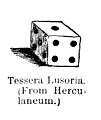Tessĕra
A square or cube; a die; a token.
1.
For the tessera used in making pavements, see
Pavimentum.
2.
As dice the tesserae were used in gambling. (See
Alea.) These were of the same form, and were commonly made of ivory, bone, or some
close-grained wood. They were numbered on all the six sides like the dice now in use (Ovid,
Trist. ii. 473 foll.); and in this respect as well as in their form they
differed from the
tali, which are often distinguished from tesserae by
classical writers (See
Talus.) Whilst four
tali were used in playing, only three tesserae were anciently
emploued.
 |
|
Tessera Lusoria. (From Herculaneum.)
|
Hence arose the proverb,
ἢ τρὶς ἕξ, ἢ τρεῖς
κύβοι, i. e. “either three sixes or three aces,” meaning all
or none (
Legg. xii. 968 E). Three sixes are mentioned as the highest throw in
the
Agamemnon of Aeschylus (
33). The die used
for gambling was called
tessera lusoria.
3.
Tessera hospitalis (
σύμβολον). A token of
mutual hospitality and friendship; consisting of a small die, which was given by a host to
his guest
 |
|
Tessera Hospitalis.
|
at the time of departure, when it was broken into two parts, each party retaining
one-half, in order that if either of them or their descendants should again meet, they might
recognize each other, and renew or repay their ancient family
obligations (Plaut.
Poen. v. 2, 86-93).
4.
Tessera frumentaria and
nummaria. A voucher or ticket
given upon certain occasions by the magistrates to the poor, in exchange for which
 |
|
Tesserae Frumentariae. (Rich.)
|
they received the quantities of bread, corn, wine, and oil, or sums of money
inscribed upon it (
Suet. Nero, 11;
Suet. Aug. 40,
Suet. Aug.,
41); or sometimes scattered in a bounty (
congiarium) amongst the
crowd by the emperors, or wealthy personages, for the purpose of courting popular favour
(
Suet. Dom. 4). See
Frumentariae Leges.
5.
Tessera theatralis. A ticket of admission to the theatre, or other place of
public amusement (
Mart.viii. 78), distributed by the
duumvir and entitling the holder to a place at the representation. On it
were inscribed the number of the seat, the division and row in which it was situate, and in
some cases the title of the play performed. See
Theatrum.
6.
Tessera militaris (
σύνθημα). A billet or
wooden tablet (Polyb. vi. 34) with the watchword inscribed upon it, which was given out by
the officers to their soldiers, in order that they might have a test for distinguishing
friends from foes; it was also employed as a means by which the orders of the commander were
distributed through the different divisions of an army (
Livy, vii.
35; xxvii. 46; Veg.
Mil. ii. 7;
Verg. Aen. vii.
637).







